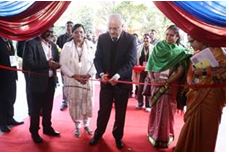



India's new satcom rules mandate 20% local manufacturing, data localization, NavIC integration, and real-time law enforcement cooperation. They ensure national security, digital sovereignty, and economic growth. Companies like Starlink and Amazon must comply to operate, aligning global tech with local laws while supporting the “Make in India” initiative.

Copyright infringement not intended
Picture Courtesy: INDIAN EXPRESS
India sets strict rules for Starlink, Amazon, and others to ensure national security and digital sovereignty in satellite communications.
The Department of Telecommunications (DoT) releases detailed guidelines, while Telecom Regulatory Authority of India (TRAI) finalizes how satellite spectrum (the radio frequencies used for communication) gets allocated.
These rules apply to global players like Starlink, Amazon’s Kuiper, and local firms like Jio, affecting how they provide internet services via satellites.
Local Manufacturing (Indigenisation)
Satcom companies manufacture at least 20% of their ground equipment (like antennas and gateways) within the country within five years of starting operations.
Companies submit a yearly plan showing how they gradually increase local production. It supports the “Make in India” initiative, reduces dependence on foreign technology, and boosts local industries.
For example, Starlink, which operates over 7,000 satellites, must source some equipment from Indian manufacturers by 2030 if it starts services in 2025.
Data Localisation
The rules ensure user data stays within India’s borders. Companies cannot route Indian internet traffic through foreign gateways or servers, nor can they copy or decrypt (decode) this data outside India.
They must set up data centers in India and handle Domain Name System (DNS) resolution (which connects website names to servers) locally. It protects user privacy and prevents foreign entities from accessing sensitive information.
For example, Starlink agrees to store all Indian customer data in India, a key step toward getting its license.
Using NavIC Navigation System
Companies must integrate NavIC, India’s homegrown satellite navigation system, into their user devices (like satellite dishes) on a “best effort” basis. They need a plan to fully adopt NavIC by 2029. It ensures satcom devices depend on Indian systems for location services, strengthening national control.
National Security and Law Enforcement Cooperation
Real-time monitoring => Companies provide live location data (latitude and longitude) of user devices to law enforcement agencies (LEAs) when requested. This helps track illegal activities, like smuggling, where Starlink devices were found in a 2024 drug bust in the Andaman and Nicobar Islands.
Special Monitoring Zones => Areas within 50 km of international borders and 200 nautical miles along coasts (Exclusive Economic Zone) face strict surveillance. Companies report foreign or unregistered devices connecting to their networks in these zones.
Service restrictions => During conflicts or emergencies, companies block services to specific users or areas as directed by authorities. This mirrors telecom rules, to ensure satcom doesn’t bypass government administration.
Lawful interception => Companies install systems to monitor and intercept communications when legally required, with network control centers located in India.
Blocking Mechanisms
Satcom companies ensure websites blocked in India (e.g., for legal or security reasons) remain inaccessible via their services. They collect metadata (data about user activities, like call logs) for the Telecom Security Operation Centre (TSOC).
Security Clearances
Companies need separate approvals for voice and data services, with each gateway (a hub connecting satellites to local networks) requiring security clearance. Starlink, for example, faces delays since 2022 due to these stringent checks but recently received a Letter of Intent (LoI) after agreeing to comply.
Boosting Local Economy => The 20% indigenisation rule creates jobs and strengthens India’s tech manufacturing. By 2028, India’s satcom market could reach $25 billion, and local production ensures India benefits economically.
Protecting Data Sovereignty => Keeping data in India prevents foreign surveillance and aligns with global trends where countries like China and the EU enforce data localization. This is critical as satcom services expand to rural areas via projects like BharatNet.
Enhancing National Security => Satellite internet can bypass traditional telecom networks, posing risks. Incidents like insurgents using Starlink in Manipur highlight the need for monitoring. The rules ensure satcom companies assist in tracking and blocking misuse.
Promoting NavIC => Adopting NavIC reduces dependence on GPS, vital for strategic autonomy, especially in defense and disaster management. By 2029, satcom devices will strengthen navigation infrastructure.
Regulating Global Giants => Companies like Starlink and Kuiper dominate globally, but rules ensure they follow local laws. This prevents unfair competition with domestic telecoms like Jio and Airtel, who argue for equal regulations.
|
The rules reflect a “hybrid” approach—welcoming tech giants while enforcing strict oversight. This balances innovation (bridging the digital divide in 625,000 villages) with security (preventing misuse in border areas). |
Must Read Articles:
Satellite-based gigabit internet
Source:
|
PRACTICE QUESTION Q. Evaluate the role of private initiatives like Starlink in bridging the digital divide. What are the potential benefits and drawbacks of such projects? 250 words |







© 2025 iasgyan. All right reserved